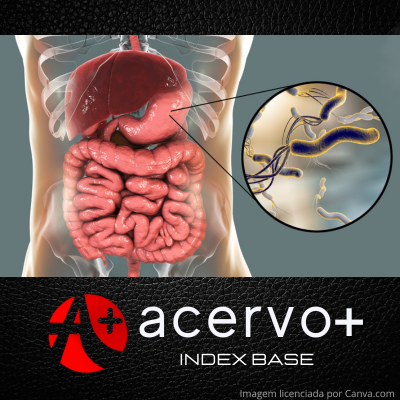Associação dos Fatores de Virulência do Helicobacter pylori com diferentes doenças gastrointestinais
##plugins.themes.bootstrap3.article.main##
Resumo
Objetivo: Investigar acerca do Helicobacter pylori e seus fatores de virulência, dada o aumento significativo de sua presença em doenças gastrointestinais. Revisão bibliográfica: Helicobacter pylori é uma bactéria gram-negativa de provável transmissão oro-fecal que coloniza o estômago da maioria das pessoas. Esta agride células epiteliais da mucosa estomacal, podendo ser assintomática ou causar diversas injúrias no trato gastrointetinal. Contudo, a prevalência de sua infecção varia de acordo com a presença de certos fatores de virulência produzidas por ela. Os genes da bactéria são classificados em diferentes tipos com base na presença e no nível de expressão de CagA e VacA, citotoxinas que codificam diversos fatores de virulência. Além disso, produzem mediadores inflamatórios responsáveis por facilitar a oncogênese. O quadro clinico mais comum é a gastrite, podendo levar ao surgimento de ulceras pépticas, adenocarcinoma gástrico e linfoma não-Hodgkin. Considerações finais: O Helicobacter pylori é considerado o agente etiológico mais comum para cânceres relacionados à infecção e variadas doenças gastrointestinais sendo sua erradicação de suma importância na profilaxia destas sendo a sua erradicação de suma importância para o tratamento e prevenção de diferentes doenças gastrointestinais.
##plugins.themes.bootstrap3.article.details##
Copyright © | Todos os direitos reservados.
A revista detém os direitos autorais exclusivos de publicação deste artigo nos termos da lei 9610/98.
Reprodução parcial
É livre o uso de partes do texto, figuras e questionário do artigo, sendo obrigatória a citação dos autores e revista.
Reprodução total
É expressamente proibida, devendo ser autorizada pela revista.
Referências
2. AMIEVA M e PEEK JRRM. Pathobiology of Helicobacter pylori induced gastric câncer. Gastroenterology, 2016; 150: 64-78.
3. ANSARI S e YAMAOKA Y. Survival of Helicobacter pylori in gastric acidic territory. Helicobacter: A 12386 ed. David Y Graham e Francis Megraud, 2017: 1-13.
4. BURUCOA C e AXON A. Epidemiology of Helicobacter pylori infection. Helicobacter: A 12403 ed. David Y Graham e Francis Megraud, 2017: 1-5.
5. CHEY WD, et al. ACG Clinical Guideline: Treatment of Helicobacter pylori Infection. Am J Gastroenterol, 2017; 112(2): 212-239.
6. COELHO E, et al. Molecular Mechanisms for Adhesion and Colonization of Human Gastric Mucosa by Helicobacter pylori and its Clinical Implications. Revista Científica da Ordem dos Médicos, 2016; 29(7-8): 476-483.
7. CORRAL JE, et al. Helicobacter pylori recurrence after eradication in Latin America: Implications for gastric cancer prevention. World J Gastrointest Oncol, 2017; 9(4): 184-193.
8. DÍAZ MM, et al. Gastric cancer: some considerations on risk factors and Helicobacter pylori. Rev Med Electron, 2018; 40(2): 433-444.
9. DOORAKKERS E, et al. Eradication of Helicobacter pylori and Gastric Cancer: A Systematic Review and Meta-analysis of Cohort Studies. JNCI J Natl Cancer Inst, 2016; 108(9): 1-9.
10. HORRIDGE DN, et al. Outer inflammatory protein a (OipA) of Helicobacter pylori is regulated by host cell contact and mediates CagA translocation and interleukin-8 response only in the presence of a functional cag pathogenicity island type IV secretion system. Pathog Dis, 2017; 75(8): ftx113.
11. HU Y, et al. Systematic review with meta-analysis: the global recurrence rate of Helicobacter pylori. Aliment Pharmacol Ther., 2017; 46(9): 773-779.
12. LADEIRA MSP, et al. Biopatologia do Helicobacter pylori. J Bras Patol Med Lab, 2003; 39(4): 335-42.
13. LEE KE, et al. Helicobacter pylori and interleukin-8 in gastric câncer. World journal of gastroenterology. 2013;19(45):8192-202.
14. MAHMOUDI L, et al. High efficacy of gemifloxacin-containing therapy in Helicobacter pylori eradication: a pilot empirical second-line rescue therapy. Medicine, 2016; 95(42): 1-5.
15. MITCHELL H e KATELARIS P. Epidemiology, clinical impacts and current clinical management of Helicobacter pylori infection. MJA, 2016; 204(10): 376-380.
16. MORAL-HERNÁNDEZ OD, et al. Multiple infections by EBV, HCMV and Helicobacter pylori are highly frequent in patients with chronic gastritis and gastric cancer from Southwest Mexico. Medicine, 2019; 98(3): 1-9.
17. NARVÁEZ CER, et al. Helicobacter pylori, peptic ulcer and gastric câncer. Rev Fac Med, 2018; 66(1): 103-106.
18. NEVES VHD, et al. Epidemiologia e fatores de risco associados às neoplasias gástricas: uma revisão de literatura. Revista Eletrônica Acervo Científico, 2021; 21: e6421.
19. NOTO JM e PEEK JRRM. The gastric microbiome, its interaction with Helicobacter pylori, and its potential role in the progression to stomach cancer. PLOS Pathogens, 2017; 13(10): 1-7.
20. QUERESHI N, et al. Probiotic therapy in Helicobacter pylori infection: a potential strategy against a serious pathogen? Applied Microbiology and Biotechnology, 2019; 103(4): 1573-1588.
21. RUGGE M, et al. Gastric cancer as preventable disease. Clin Gastroenterol Hepatol, 2017; 15(12): 1833-1843.
22. SAKITANI K, et al. Early detection of gastric cancer after Helicobacter pylori eradication due to endoscopic surveillance. Helicobacter: A 12503 ed. David Y Graham e Francis Megraud, 2018: 1-7.
23. VINAGRE RMDF, et al. Helicobacter pylori infection and immune profile of patients with diferente gastroduodenal diseases. Arq Gastroenterol, 2018; 55(2): 122-127.
24. YEH Y, et al. H. pylori isolates with amino acid sequence polymorphisms as presence of both HtrAL171 & CagL-Y58/E59 increase the risk of gastric câncer. Journal of Biomedical Science, 2019; 26(4): 1-8.
25. ZAVROS Y e MERCHANT JL. The immune microenvironment in gastric adenocarcinoma. Nat Rev Gastroenterol Hepatol, 2022; 19(7): 451-467.

